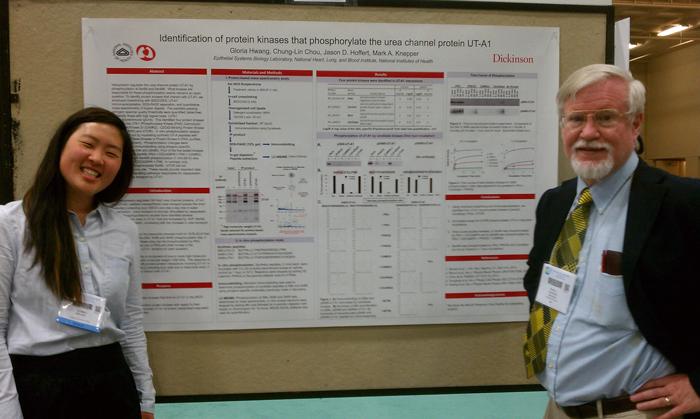Experimenting With Success

Gloria Hwang '16 with Mark A. Knepper at her presentation at the 2014 Experimental Biology Conference.
Dickinson Science Magazine Founder and Editor-in-Chief Gloria Hwang '16 reflects on the history of research at Dickinson
by Gloria Hwang '16
This article first appeared in the fall 2014 issue of Dickinson Science Magazine, which is published twice a year. Look for the spring 2015 issue in April.
In December 1815, chemistry professor Thomas Cooper and his student James Hamilton Jr. conducted one of the first student-faculty research collaborations at Dickinson and published their work in the Philadelphia Port Folio magazine. Since then, generations of Dickinson students have conducted research on campus and worldwide. Their experiments range from the first studies using Joseph Priestley’s burning glass in 1815 to a study of giant viruses in Zurich, Switzerland, in 2013 and the many experiments conducted today.
Research continues to be an important part of our science programs. In 1985, Dickinson held its first undergraduate science research symposium. Today, this hugely popular event showcases the scientific discoveries of many student researchers. Moreover, Dickinson was the first college to incorporate field studies into its science courses, and it continues to add fascinating, hands-on lab experiments to the curriculum. During my first two years at Dickinson, I had the opportunity to give poster presentations for Associate Professor of Chemistry Amy Witter’s analytical chemistry lab on antioxidants and for Associate Professor of Biology Michael Roberts’ genetics lab on mutagenesis.
[In spring 2014], with the support of my professors and the Career Center, I presented my research at the 2014 Experimental Biology Conference in San Diego, Calif. More than 14,000 scientists from around the world attended the conference. They participated in lectures, poster sessions, career service workshops and technology exhibits. Some of the research areas represented included physiology, biochemistry, pharmacology, mathematics and statistics, chemistry, psychology, environmental studies and many interdisciplinary fields.
My presentation was on the kidney physiology research that I had conducted at the National Institutes of Health (NIH) in 2013 under Senior Investigator Mark A. Knepper, who has been a scientist at the NIH since 1978 and is currently head of the Epithelial Systems Biology Laboratory. He has received the highest award of the American Society of Nephrology, the H. W. Smith Award, and has published more than 400 peer-reviewed papers in renal physiology. In addition, Knepper has co-authored papers and collaborated with Peter C. Agre, the discoverer of aquaporins, the 2003 Chemistry Nobel Laureate and Dickinson’s 2005 Joseph Priestley Award recipient.
Knepper’s lab studies the hormone vasopressin and its ability to regulate water and salt transport in the basic unit of the kidney called the nephron. He has discovered that urea transport in renal collecting ducts, which are the final components of the nephron, occurs through urea channel proteins. Knepper has pioneered methods for applying phosphoproteomics, a branch of proteome studies that distinguishes proteins with an attached phosphate group to signaling systems. From these methods, he and his team have revealed classes of protein kinases, which attach phosphate groups to other proteins through a process called phosphorylation. This led to the further understanding of how vasopressin regulates the phosphorylation of various protein kinases. My research focused on the identification of these kinases that phosphorylate the urea channel protein UT-A1. During my summer at the NIH, I met several of my future mentors, most notably Chung Lin (Joe) Chou, Jason D. Hoffert and Carolyn M. Ecelbarger.
In 1809, Dickinson founder Benjamin Rush wrote about the importance of research and scientific inquiry when he stated, “Upon all new and difficult subjects there must be pioneers.” With this in mind, the editors of Dickinson Science Magazine have decided to research the history of science at Dickinson, beginning with Rush—a physician, professor of chemistry and father of American psychiatry. During his time, Rush was a scholar and author, publishing numerous textbooks in the fields of chemistry, psychiatry and medicine. And like every student today, Rush studied under great mentors who acknowledged his endeavors and encouraged his success.
I continue to be inspired by Rush. I had the opportunity to visit his memorial site at Christ Church Burial Ground in Philadelphia last summer. During my trip, I reflected not only on his many contributions to science but also on his work opposing slavery and promoting reforms in women’s education and mental-health treatment. I paid my respects to his many great services to the college and to the rest of the world.
Thus, like the start of many research initiatives, this issue acknowledges what has preceded us, and I would like to thank Dickinson’s Archives & Special Collections for guiding us in our search. We have dedicated this issue to recognizing the history of science at Dickinson and hope that you are informed, educated and inspired after reading it.
Learn more
- Dickinson Science Magazine
- "First Dream, Then Do"
- Research at Dickinson
- Department of Biochemistry & Molecular Biology
- Latest News
Published March 2, 2015